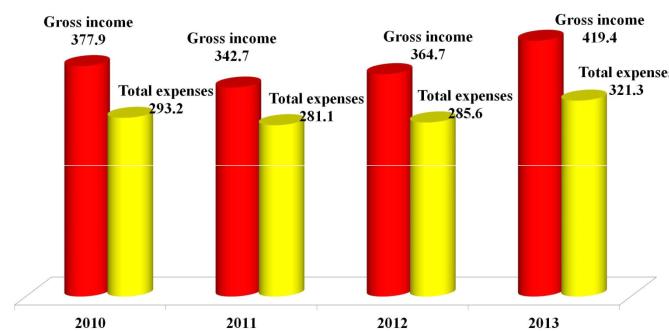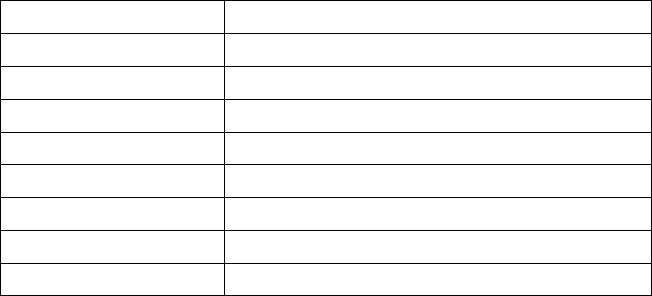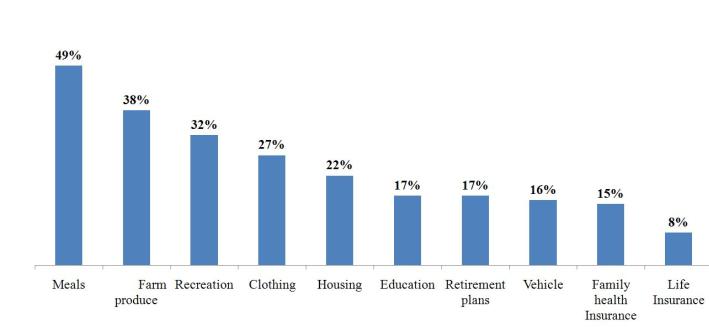
posobie
.pdfV. Read the text. Name it. Divide it into parts. Name each part. Explain the
meaning of the words in bold type.
Text III. __________
Through the production of goods and services the firm generates profits. Therefore, assessing the production/operations process and making plans for the future is vitally important. This may be particularly important in cases where a farm is planning to expand or where a change in business enterprises is to occur.
Provide a summary of the SWOT analysis for production/operations. This may be the most important area to gather input from employees, who are likely the ones most closely associated with daily production. Therefore, their insights could provide a valuable additional perspective. Outline what productive assets are necessary to make your product or provide your service. The following deserve particular attention:
Land.
Buildings.
Other Facilities (particularly if on-farm processing is involved).
Equipment and Machinery.
Materials and Supplies.
Focus on what the firm currently owns, the quality of those assets, and how others will be obtained, if needed. Only discuss the resources needed. Save any discussion of financing these assets for the Financial Management section. Describe your current production practices. How much do you produce? When do you produce it? You may want to develop a visual approach to help tell this story. A time line could help to describe when products are made or services are sold. The more complex the business is, the more useful a visual might be. Government regulations affect production in many industries. This is particularly the case in production agriculture. If producing agricultural products, be sure that you are complying with all relevant regulations. These include, but may not be limited to:
Manure management.
Soil conservation.
Worker Safety.
41
Zoning.
Inspections of the product and of the production facilities.
Now that you have laid out your current production practices and defined some firm and industry trends as they relate to some important benchmark measures, it is time to describe your productionor operations-related plans. As you do this, be sure to set specific production goals, outline potential changes in enterprises or production practices, and describe how you plan to locate and purchase inputs. One of the most important—yet most often overlooked—inputs is labor. The competency of your human resources may dictate how successfully your business will perform. Use this section to outline your current human resource (HR) policies, how these may change over the planning period, and what you or other managers may need to do to improve HR management. Begin by providing a current organizational chart. It allows the employees to see their position in the firm. Also, the chart should show that each person has only one immediate supervisor. We cannot stress this point enough. Defining the managerial structure so that employees are directly responsible to only one person is very important. Often the partners who own the farm tend to supervise employees together. This results in a situation in which the employee may get conflicting directions. If the employee has only one direct supervisor, this situation can be avoided. Whether formalized or not, your firm has HR policies. While we encourage you to formalize those if they are not already, you should complete this section with the most accurate information you have at your disposal. Think about the following individual points as you consider what you would like to include in this section. Also, remember to include information regarding all employees of the business, including the management team. Compensation and
Benefits—How much do you pay your employees? At what intervals are they paid (for example, weekly or monthly)? What sort of benefits package is offered? Does the package differ by type of employee? Do you have an incentive plan for employees? Are owner/ operators paid a salary or do they capture retained earnings? Job Descriptions and Recruiting— Does each position have a written job description? Are these used to assess the suitability of potential employees? How do you recruit new workers/managers? Provide written copies of job announcements
42
and descriptions in an appendix. Training and Standard Operating Procedures— What training is provided for new employees? What training is provided when employees assume new responsibilities? Are common task sequences documented with written standard operating procedures (SOPs)? Performance Evaluation and
Performance Feedback—Is there a formal mechanism for evaluating workers’ performances? If so, how frequently is performance assessed? How does the employee receive the manager’s assessment? Are salaries or wages based at least partially on these evaluations? Once you have outlined your production and marketing plans, you must evaluate the ramifications of those plans for the firm’s human resources. Will the plan require any shift in HR policy? If so, how? For example, an expanding custom heifer grower may need to hire a full-time nutritionist to be sure that the heifers are receiving a properly balanced ration as they develop. The best way to reflect these changes may be to provide one or more additional organizational charts showing how the organization is expected to change over time. In the text, be specific as to what changes are to be made and when. Also, be sure to describe any changes you plan to make in your HR management. If you don’t have formal job descriptions, standard operating procedures, or evaluations, for example, you should consider putting those in writing. Also indicate if the plan will require additional training of existing and new employees. Finally, if expanding, describe where you might find potential employees.
1.Answer the following questions:
1)What sections of the sample business plan are considered in the text?
2)Why is providing a summary of the SWOT analysis for production and operation so important?
3)What productive assets can be necessary for the production of goods and services?
4)What government regulations can affect agricultural production?
5)Why is labor one of the most important inputs?
6)What is the purpose of a current organization chart?
7)What are HR policies? Why are they so important?
43
2. Give the terms after their definitions.
Term |
Definition |
|
|
|
detailed examination of the elements or structure of something. |
|
|
|
a series of mechanized or chemical operations to change |
|
something. |
|
|
|
graphical representation of a period of time, on which important |
|
events are marked. |
|
|
|
the preservation of soil against deterioration or erosion. |
|
|
|
a place or piece of equipment provided for a particular purpose. |
|
|
|
a standard or point of reference against which things may be |
|
compared. |
|
|
|
a person who directly manages someone’s work. |
|
|
|
the money received by an employee from an employer. |
|
|
|
to enroll someone as a worker in an organization. |
|
|
|
complex or unwelcome consequence of an action or event. |
|
|
|
a person who studies or is an expert in feeding. |
|
|
3.Make the annotation of the text.
V. Translate the text into English. List the keywords. Make the English summary of the text.
Text VI. Важность бизнес-плана
Бизнес-план необходим, чтобы убедить инвестора: предприятие будет иметь успех и в него стоит вкладывать деньги. Все продумано, просчитано, а
риски оправданны. Но работа над планом поможет и самому предпринимателю вовремя заметить подводные камни и избежать их.
Инвестор уже знает, куда вложить деньги, но с опаской поглядывает на заемщика, боясь прогадать, а бизнес-план поможет успокоить инвестора,
утверждает Дмитрий Алексанов, заведующий кафедрой информационно-
консультационных технологий в АПК Московской сельскохозяйственной академии им. К.А. Тимирязева. По бизнес-плану можно судить, насколько бизнесмен способен продумать все стадии реализации проекта, считает Алексанов. «Между людьми, привыкшими давать деньги под честное слово, по-
44
прежнему курсируют большие суммы, но по мере становления цивилизованного рынка такое случается все реже, – говорит директор департамента стратегического бизнес-планирования и экспертизы проектов компании
«Росхлебопродукт» Сергей Голембиовский. – Без бизнес-плана сейчас невозможно получить кредит ни у банка, ни тем более у западного инвестора».
Но если бизнес-план делается с установкой «нам нужно столько-то денег,
вернуть их должны через два года, вот мы и обоснуем сейчас все это», то при анализе инвестором плана этот подход виден. Инвестору требуется обоснование объема продаж и уровня затрат, ответ на вопрос, почему именно эти цифры, а он получает что-то из разряда «а почему бы и нет», говорит Константин Овчаренко, консультант компании BKG.
Некоторые консультанты советуют писать бизнес-план с позиций инвестора. Но Дмитрий Алексанов считает, что такая практика порочна. Его,
инвестора, в первую очередь интересуют окупаемость и гарантии. «А что же,
свой интерес – дело десятое? На моей памяти несколько предприятий получили неплохие деньги на хороших условиях и в срок вернули их инвестору, но сами обанкротились. А если бы они первым делом свою выгоду преследовали,
может, выжили бы», – говорит он.
Хотя бизнес-план делается с целью получения инвестиций, он необходим для самого бизнесмена, чтобы еще раз просчитать все возможные варианты и найти оптимальное решение. Дмитрий Алексанов приводит в пример предприятие, добивавшееся кредита в $25 млн для строительства современного тепличного комбината в Подмосковье. В ходе работы над бизнес-планом выяснилось, что, несмотря на высокую рентабельность проекта, срок его окупаемости – 11 лет. Тогда вместо строительства нового тепличного комбината деньги вложили в реорганизацию уже существующего. Это обошлось в $2 млн и окупилось через два года, несмотря на меньшую рентабельность хозяйства. А Сергей Голембиовский, улыбаясь, рассказывает,
как во время написания бизнес-плана входящий в «Росхлебопродукт»
«Cтавропольский бройлер» отказался от многолетней традиции закупать работающие на бензине трактора – солярка оказалась выгоднее.
VII. Make a presentation in English representing a simple business plan.
45

UNIT 4
FARM FINANCIAL MANAGEMENT
I. Find the translation of the given words. Write them down.
balance sheet |
deduction |
mutual fund |
partial budget |
beneficiary |
employee |
net pay |
sick pay |
benefit |
enterprise budget |
paycheck |
performance |
bonus |
optional |
liquidity |
profit sharing |
budget |
impose |
principal |
retirement |
cash flow |
lender |
snapshotview |
revolving credit |
cohort |
narrative |
liquidity |
social security |
gross pay |
outstanding debt |
solvency |
tax-deferred |
II.Comment on the Figure 1 and make assumptions of the profitability of farming in the USA.
Figure 1. The incomes and expenses of the US farming by years (in bln. dollars)
46
III. Read the text. Translate and explain the words in bold type.
Text I. Financial Management.
Here, you should tie together the details in the rest of the plan in terms of how they affect the firm’s financial performance. Ultimately, operating a business is about making money. Therefore, this section needs to allow the reader to assess where the firm is and where it intends to go over the planning horizon. Although you should provide current and projected future financial statements with the plan, they might be best presented in an appendix. This section should be mostly a verbal explanation of the business’s finances, with perhaps a few tables to highlight important information.
Because this section is so important, especially if financing is being pursued, we highly recommend that you work with a business consultant, accountant, or other financial advisor to develop it.
You should highlight the important points of your financial statements (income statement, , and statement of cash flows). Focus on the positive aspects, while not ignoring the negative. You do not want to provide a potential lender with an impression that you are trying to hide information. It might help if you work with a financial advisor to develop this narrative.
Provide a table of current outstanding debt. Include the terms of the debt, the lender(s), the principal amount, your payment amount(s), how frequently you make payments, and how many payments remain. Furthermore, a table of financial ratios would be useful in providing a snapshot view of the firm. You will want to provide measures of profitability, financial efficiency, liquidity, and solvency. Provide other sources of managerial decision-making input. For many farm owners, this is the most difficult facet to monitor. Using a business consultant, a CPA, or some other financial advisor may increase farm profits as you allow some of these individuals to help analyze financial data and make recommendations for you to review.
Financial Strategy. At this point, you need to set forth your plan for financing the firm’s operations over the planning period. Where will you get money when you need to purchase a new truck or replace your barn, for example? Also, you should relate your financial plan to your production, marketing, and human resources
47
plans. A time line relating events planned in the other sections to financing may help to clarify this section’s message for the reader.
In your discussion, be sure to let the reader know how you will assess financial performance. Will you require that net income grow by 8 percent per year, for example? Set goals for the measures you have used previously to describe the health of the business. Therefore, you should aim for specific values for your selected measures of profitability, financial efficiency, solvency, and liquidity. Also, do not forget that an information management system should be in place so that the financial data you gather is accurate.
You should be realistic with your plans, yet push yourself. Stated differently, you should plan to succeed, not just survive. If your business is to be viable over the long term, then you should generate returns to grow the business, grow equity, improve your credit-worthiness, and otherwise improve the odds of operating this business well into the future.
If the plan covers a major shift in the business’s operations, such as a large expansion, then special care is needed to discuss how cost overruns might be handled, when production will begin in a new facility, when debt repayment will commence, and so forth. Although the planning process should reduce the amount of uncertainty associated with such a change, it can never eliminate uncertainty. Therefore, it should be noted that insurance may be used to protect the firm against financial losses that may be associated with operating a business. Be sure to define your insurance needs in this section of the business plan.
Uncertainty should also be accounted for in your financial estimations. Let the reader know what assumptions you have made when developing the pro forma statements. Also, some sensitivity analyses would be useful to show how your statements would change if output or input prices were different from your projections. If appropriate, set forth some contingency plans to be enacted if certain undesired outcomes are realized. For example, if milk production suffers from a hot, dry summer, you should have a contingency plan in place to help cash flow the business until production increases. For example, such a plan might include a revolving line of credit with the local bank.
48

1.Answer the following questions:
1)What does the section Financial Management need to? Why is it so important?
2)What does a table of current outstanding debt include?
3)Why is Financial Strategy necessary?
4)Why is it necessary to define insurance needs in the business plan?
5)What is the main purpose of this business plan section
6)Should the farmer follow the saying “The ends justify the means” when writing this section?
2.Give the definitions of the following terms: (table)
Term |
Definition |
Financial statement
Accountant
Balance sheet
Principal amount
Solvency
Net income
Equity
Loss
3.Define if these sentences are true or false. Correct the false sentences.
1)Operating a business is about spending money.
2)Financial Management section is a verbal explanation of a business’
finances.
3)To develop Financial Management section you shouldn’t work with financial advisor.
4)You should ignore negative and focus on the positive aspects only highlighting the important points of your financial statements.
5)A table of financial ratios would be useful in providing a snapshot view of
the firm.
49

6)You should relate you financial plan to your production, marketing and human resource plans.
7)You should aim for specific values for your selected measures of profitability, financial efficiency, solvency, and liquidity.
8)The planning process can eliminate uncertainty.
9)You should define your insurance needs in the business plan.
10)Some sensitivity analysis would be useful to show how your financial statements would change.
4.Find the synonyms to the given words among the terms in bold type
and make sentences with them on the topic of the unit:
The creditor, the worker, the technology, the salary, the rival, the result, the resources, to protect, the product, the overdraft, the motive, the means, the creditworthiness, the conditions, the company, the bookkeeper, the agreement, the advantage.
IV. Comment on Figure 2. Make assumptions of the reasons for the illustrated trends.
Figure 2. The percentage of farm employee provided with benefits
V. Read the text and try to explain the meaning of the words in bold type. Text II. Planning and preparing a budget
A budget is a plan for spending and saving money. A good budget is an essential tool in every household. This fact comes as no surprise to most of us, yet 90 to 95
50
